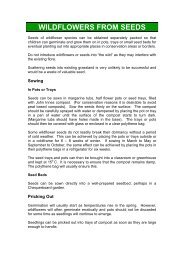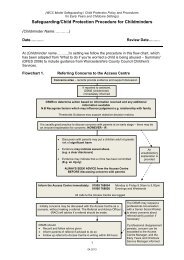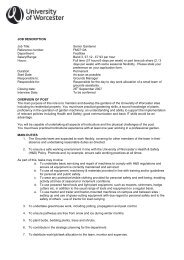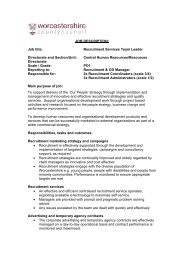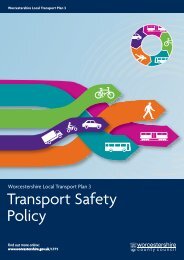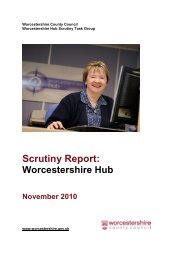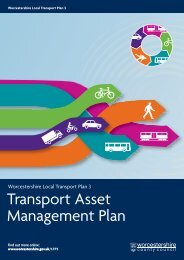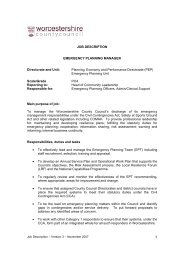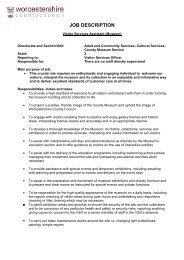Planning for Renewable Energy in Worcestershire Research Paper
Planning for Renewable Energy in Worcestershire Research Paper
Planning for Renewable Energy in Worcestershire Research Paper
Create successful ePaper yourself
Turn your PDF publications into a flip-book with our unique Google optimized e-Paper software.
Appendix A. Characteristics and Appraisal ofdifferent <strong>Renewable</strong> <strong>Energy</strong> technologies <strong>in</strong><strong>Worcestershire</strong>Large-Scale W<strong>in</strong>d Turb<strong>in</strong>esLarge-scale w<strong>in</strong>d power, <strong>in</strong> the <strong>for</strong>m ofs<strong>in</strong>gle w<strong>in</strong>d turb<strong>in</strong>es, or group<strong>in</strong>gs ofturb<strong>in</strong>es <strong>in</strong> w<strong>in</strong>d farms, currently has thegreatest potential to help the UK meet itsnational energy targets. However, at theCounty level, it may not be the mostappropriate means of deliver<strong>in</strong>g onemerg<strong>in</strong>g regional/sub-regional targets,<strong>for</strong> reasons of technical viability, andenvironmental/social/economicacceptability.As a land-locked County, <strong>Worcestershire</strong>evidently has less capacity to generatew<strong>in</strong>d energy than some coastalauthorities. The practical and policyconstra<strong>in</strong>ts that apply across the Countywill require any potential sit<strong>in</strong>g of largeturb<strong>in</strong>es to be carefully evaluated aga<strong>in</strong>sta clear set of criteria.Technical Constra<strong>in</strong>tsThe primary technical constra<strong>in</strong>t whenlook<strong>in</strong>g at w<strong>in</strong>d power will be theavailability of a sufficient w<strong>in</strong>d resource.This means that <strong>in</strong><strong>for</strong>mation on the w<strong>in</strong>dspeed and 'w<strong>in</strong>d profile' of any potentialsite should be available. W<strong>in</strong>d profilesprovide details on the direction of thew<strong>in</strong>d, and the different times <strong>in</strong> which itblows <strong>in</strong> particular directions. Thesuccessful operation of w<strong>in</strong>d turb<strong>in</strong>esrelies on an average w<strong>in</strong>d speed <strong>in</strong>excess of 6m/s (optimum speed is <strong>in</strong> therange 13-25m/s). Below this threshold,the mechanics of the turb<strong>in</strong>es do notallow them to work efficiently, althoughthe m<strong>in</strong>imum operational w<strong>in</strong>d speed isgradually decreas<strong>in</strong>g.The 2001 study '<strong>Renewable</strong> <strong>Energy</strong>Prospects <strong>for</strong> the West Midlands' <strong>in</strong>cludedsome large-scale w<strong>in</strong>d mapp<strong>in</strong>g thatcharted those areas with sufficientaverage w<strong>in</strong>dspeed <strong>for</strong> turb<strong>in</strong>es tooperate (see Appendix F). Based on thismapp<strong>in</strong>g, it seems <strong>Worcestershire</strong> haslarge areas capable of deliver<strong>in</strong>g w<strong>in</strong>dpower, predom<strong>in</strong>antly <strong>in</strong> a belt stretch<strong>in</strong>gfrom the centre of the County to the southand the east. The maps show thatapproximately half of the County iscovered by 'plann<strong>in</strong>g constra<strong>in</strong>ts',although it would be <strong>in</strong>correct to assumethat these are absolute constra<strong>in</strong>ts tow<strong>in</strong>d development. It is important to notethat any w<strong>in</strong>d speed mapp<strong>in</strong>g must not beused to categorically exclude future sites.One of the Government's key pr<strong>in</strong>ciples <strong>in</strong>PPS22 makes clear that to exclude apotential renewable resource based solelyon "assumptions about the technical orcommercial feasibility" is unacceptable,and that "Technological change can meanthat sites currently excluded as locations<strong>for</strong> particular types of renewable energydevelopment may <strong>in</strong> future be suitable". 32For this reason, w<strong>in</strong>d turb<strong>in</strong>es and w<strong>in</strong>dfarms proposed <strong>in</strong> areas outside of thoseidentified on the w<strong>in</strong>d resource mapcannot be excluded from consideration,but it is recognised that <strong>in</strong> the currentmarket, with current technologies, thelikelihood of development proposalscom<strong>in</strong>g <strong>for</strong>ward <strong>in</strong> these areas is m<strong>in</strong>imal.The West Midlands Regional Urban W<strong>in</strong>dCapacity Study (June 2004) confirmedthat w<strong>in</strong>d speed is the pr<strong>in</strong>cipalconsideration when look<strong>in</strong>g <strong>for</strong> potentialsites, stat<strong>in</strong>g that "As a rule, developersuse this data as a guide and supplementit with on-site data prior to assess<strong>in</strong>g thedeliverability of sites".APPENDIX A ● <strong>Plann<strong>in</strong>g</strong> <strong>for</strong> <strong>Renewable</strong> <strong>Energy</strong> <strong>in</strong> <strong>Worcestershire</strong>32Paragraph 1(v), Key Pr<strong>in</strong>ciples, <strong>Plann<strong>in</strong>g</strong> PolicyStatement 22: <strong>Renewable</strong> <strong>Energy</strong>, DCLG (2004)Technical <strong>Research</strong> <strong>Paper</strong> 33



